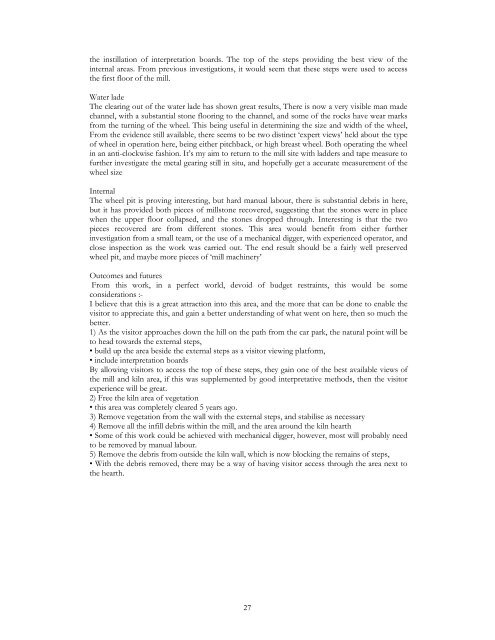TAYNISH MILL - Scottish Natural Heritage
TAYNISH MILL - Scottish Natural Heritage
TAYNISH MILL - Scottish Natural Heritage
Create successful ePaper yourself
Turn your PDF publications into a flip-book with our unique Google optimized e-Paper software.
the instillation of interpretation boards. The top of the steps providing the best view of the<br />
internal areas. From previous investigations, it would seem that these steps were used to access<br />
the first floor of the mill.<br />
Water lade<br />
The clearing out of the water lade has shown great results, There is now a very visible man made<br />
channel, with a substantial stone flooring to the channel, and some of the rocks have wear marks<br />
from the turning of the wheel. This being useful in determining the size and width of the wheel,<br />
From the evidence still available, there seems to be two distinct ‘expert views’ held about the type<br />
of wheel in operation here, being either pitchback, or high breast wheel. Both operating the wheel<br />
in an anti-clockwise fashion. It’s my aim to return to the mill site with ladders and tape measure to<br />
further investigate the metal gearing still in situ, and hopefully get a accurate measurement of the<br />
wheel size<br />
Internal<br />
The wheel pit is proving interesting, but hard manual labour, there is substantial debris in here,<br />
but it has provided both pieces of millstone recovered, suggesting that the stones were in place<br />
when the upper floor collapsed, and the stones dropped through. Interesting is that the two<br />
pieces recovered are from different stones. This area would benefit from either further<br />
investigation from a small team, or the use of a mechanical digger, with experienced operator, and<br />
close inspection as the work was carried out. The end result should be a fairly well preserved<br />
wheel pit, and maybe more pieces of ‘mill machinery’<br />
Outcomes and futures<br />
From this work, in a perfect world, devoid of budget restraints, this would be some<br />
considerations :-<br />
I believe that this is a great attraction into this area, and the more that can be done to enable the<br />
visitor to appreciate this, and gain a better understanding of what went on here, then so much the<br />
better.<br />
1) As the visitor approaches down the hill on the path from the car park, the natural point will be<br />
to head towards the external steps,<br />
• build up the area beside the external steps as a visitor viewing platform,<br />
• include interpretation boards<br />
By allowing visitors to access the top of these steps, they gain one of the best available views of<br />
the mill and kiln area, if this was supplemented by good interpretative methods, then the visitor<br />
experience will be great.<br />
2) Free the kiln area of vegetation<br />
• this area was completely cleared 5 years ago.<br />
3) Remove vegetation from the wall with the external steps, and stabilise as necessary<br />
4) Remove all the infill debris within the mill, and the area around the kiln hearth<br />
• Some of this work could be achieved with mechanical digger, however, most will probably need<br />
to be removed by manual labour.<br />
5) Remove the debris from outside the kiln wall, which is now blocking the remains of steps,<br />
• With the debris removed, there may be a way of having visitor access through the area next to<br />
the hearth.<br />
27
















